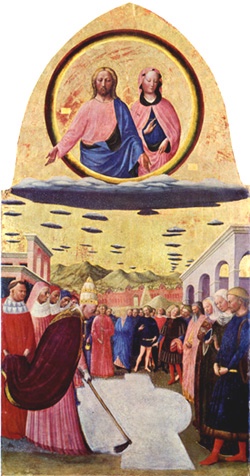
Pope Liberius defines in the snow the future site of Santa Maria Maggiore Masolino da Panicale, c. 1400
DEDICATION OF THE CHURCH OF OUR LADY OF THE SNOWS (ST. MARY MAJOR); SAINT OSWALD (A.D. 642) King, Martyr
GREATER DOUBLE / WHITE
This church is also called St. Mary Major because it is, both in antiquity and dignity, the most eminent among churches in Rome dedicated to God in honor of the Blessed Virgin. A popular legend relates that the Mother of God herself chose the site of this church, indicating it by a miraculous fall of snow on this spot in summer. By the generosity of the devout Spanish sovereigns, the ceiling of the great nave of the church is covered with the first gold brought from the New World.
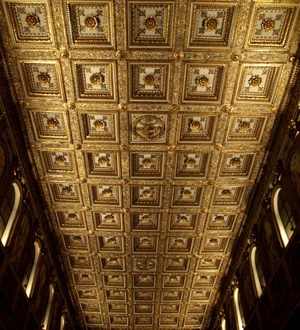
The ceiling of the Basilica is gilded with the first gold from the Americas
INTROIT
Hail, holy Parent, that didst bring forth the King who ruleth Heaven and earth for ever and ever.
Ps. 44:2. My heart hath uttered a good word: I speak of my works to the King.
V. Glory be . . .
COLLECT
Grant Your servants continual health of mind and body, O Lord God, and let the intercession of the blessed ever-Virgin Mary gain for us freedom from our present sorrow so that we may enjoy everlasting happiness. Through our Lord . . .
Commemoration of SAINT OSWALD
St. Oswald, king of Northumbria, assisted St. Aidan in spreading the Faith of Christ among his people. He died on the battlefield, when his country was invaded by the pagan Mercians, A.D. 642.
Almighty and everlasting God, who hast made holy the sweet and blessed happiness of this day by the martyrdom of the blessed king Oswald, grant to our hearts an increase of Thy love, so that we may imitate his steadfastness unto death, whose glorious struggle for the faith we admire. Through our Lord . . .
LESSON Eccl. 24:14-16 [Sirach]From the beginning, and before the world, was I created, and unto the world to come I shall not cease to be, and in the holy dwelling place I have ministered before him. And so was I established in Sion, and in the holy city likewise I rested, and my power was in Jerusalem. And I took root in an honourable people, and in the portion of my God his inheritance, and my abode is in the full assembly of saints.
GRADUAL
Blessed and venerable art thou, O Virgin Mary, who without loss of purity wert found to be the Mother of our Savior. Virgin Mother of God, He whom the whole world cannot hold enclosed Himself in thy womb, and became man.
Alleluia, alleluia!
After His birth a Virgin entire thou didst remain, O Mother of God, intercede for us. Alleluia!
GOSPEL Luke 11:27-28
And it came to pass, as he spoke these things, a certain woman from the crowd, lifting up her voice, said to him: “Blessed is the womb that bore thee and the paps that gave thee suck.” But he said: “Yea rather, blessed are they who hear the word of God and keep it.”
OFFERTORY ANTIPHON Luke 1:28, 42
Hail Mary, full of grace, the Lord is with thee: blessed art thou among women and blessed is the fruit of thy womb.
SECRET PRAYER
O Lord, through Your mercy and the intercession of the Blessed Ever-Virgin Mary, let this offering bring us prosperity and peace now and forever. Through our Lord . . .
Commemoration of SAINT OSWALD
Receive our gifts and our prayers, we beseech Thee, O Lord, cleanse us by the heavenly Mysteries and mercifully hear us. Through our Lord . . .
COMMUNION ANTIPHON
Blessed is the womb of the Virgin Mary, which bore the Son of the Eternal Father.
POSTCOMMUNION
O Lord, grant that we who have received the Sacrament of our salvation may be protected through the intercession of the Blessed Ever-Virgin Mary, in whose honor we have offered this Sacrifice to Your majesty. Through our Lord . . .
Commemoration of SAINT OSWALD
Grant, we beseech Thee, o Lord, our God, that as we rejoice on earth in keeping the memory of Thy saints, so also we may enjoy their company for evermore. Through our Lord . . .
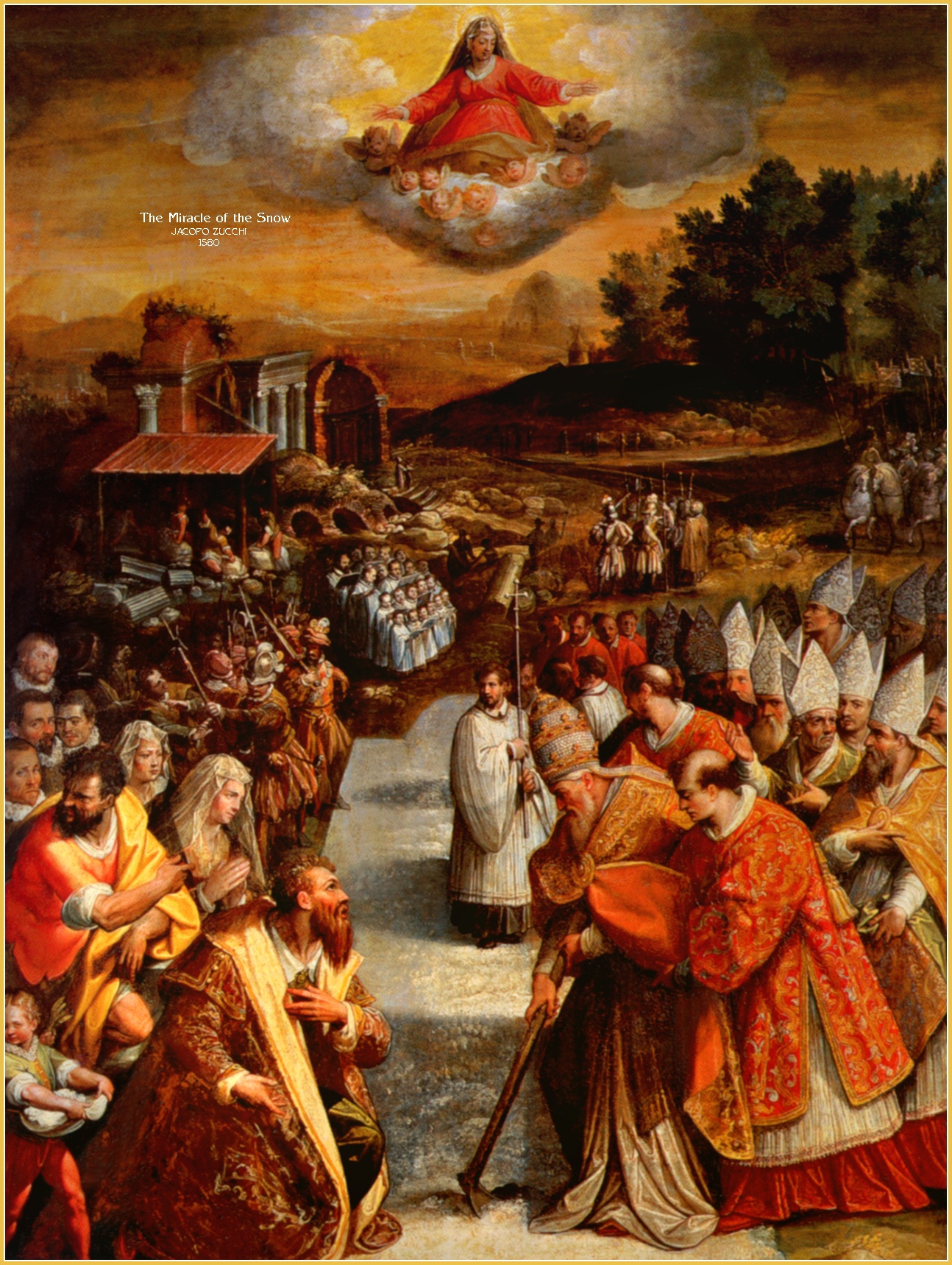
The Miracle of the Snows, by Jacopo Zucchi, ca. 1580; from the Vatican Museums.
The Dedication of Saint Mary Ad Nives
The Catholic Church celebrates today the annual feast of the dedication of a very remarkable church at Rome, called Saint Mary Ad Nives – a Saint Mary of the Snow,” or “Saint Mary Major.” The origin of this church is as follows: In the middle of the fourth century, at the time of Pope Liberius, there resided at Rome a nobleman named John. Although rich in temporal goods, he was still wealthier in those which are not of this world, and his wife was his equal in birth, riches and virtue. They had been married many years without having been blessed with children, although they had often prayed to God for them. At last, they resigned themselves to the will of Providence, and resolved to employ all their wealth in honor of the Blessed Virgin, and make her heir to it, as they had always entertained great devotion for her.
They were, as yet, uncertain as to the manner in which they should carry out their intention. They both sought refuge in prayer and alms, begging the Blessed Virgin to teach them how they might best appropriate their possessions to her honor.
Mary, the Divine Mother, deigned to make her wishes known to them. Appearing to them both in the night, she told them to go, on the following day, which was the fifth of this month, to the Aisquiline mount, in Rome, and to build a church in her honor on the spot which they would find covered with snow. This, she added, would be more agreeable to her than anything else they could do. When they awoke next morning and told each other their dream or rather their vision, they were filled with inexpressible joy, and immediately repaired to Pope Liberius to hear his opinion on the subject As the Pope had had the same vision the same night, there was no longer reason to doubt the truth of the revelation. Assembling the clergy and people without delay, the Pontiff formed a procession to go to the appointed spot. When they arrived there, they saw, in truth, a place large enough for a church, covered with snow. All were greatly surprised at this, which they could not but consider a miracle, since it was in the midst of summer, on the fifth of August, when neither in Rome nor within many miles of it, any snow could naturally have fallen. The pious couple drew from this fact the greatest comfort, as it was an indication that the Almighty and the Blessed Virgin were pleased with their intention. Therefore, hesitating no longer, they forthwith made all the necessary preparations for building a magnificent temple. The building was begun and very soon completed. All that was needed for its erection, as well as for its maintenance, was joyfully furnished. Pope Liberius most solemnly consecrated the new temple; and all the faithful went to it to venerate the Queen of Heaven. At first, this church was called the Basilica, signifying a palace, or the Liberian Basilica, on account of its royal magnificence. It was also called Saint Mary ad Nives, for the reason mentioned above. Today it is known as the Saint Mary Major, or the Great, as it is the greatest of all the churches of Rome built in honor of the Blessed Virgin, on account of its origin, magnificence and rich endowment. It is also called Saint Mary ad Praesepe – Saint Mary of the Manger – because in one cf its chapels, the crib or manger, in which the new-born Saviour was placed by his virgin mother, is kept. Pope Gregory the Great, in 509, formed and led the great procession, celebrated in the annals of the church, to implore God, through the intercession of Mary, to avert the dreadful pestilence which ravaged Rome. Its fury somewhat abated, but as it was still in the city, the Pope, in the following year, formed a second procession, headed by the picture of the Blessed Virgin painted by Saint Luke, which is kept in the church of Saint Mary ad Nives. During the procession, the pestilence left all those houses by which the picture passed, until, at last, when the faithful dispersed, the whole city was free from the terrible scourge. Another miraculous event occurred during the procession, which must not be omitted. Angels were heard singing: “Rejoice, O Queen of Heaven, Alleluia. He whom you did deserve to bear. Alleluia! is risen as He said, Alleluia!” The holy Pope, prostrating himself with all the people, finished the angels’ hymn of praise with the words: “Pray for us to God, Alleluia!” When the procession had reached the Mausoleum, or tomb of the Emperor Adrian, the Pope saw upon its summit an angel sheathing his sword, as a sign that the wrath of the Almighty was appeased by the intercession of Mary, and that the pestilence which had so long ravaged the city, would disappear. The rejoicing of the people, and the devotion which was from that time shown to the miraculous picture of the Blessed Virgin, cannot be worthily described.
Practical Considerations
• Those who are not Catholics and who blame us for our veneration of the Queen of Heaven and for the churches built in her honor, may see by the origin of the church of Saint Mary ad Nives, how ancient this pious practice is, and how agreeable to God. The building of this celebrated church took place in the fourth century, at a time when Protestants themselves say that the Catholic Church was still the true Church of God Even at that re- mote period, Mary was venerated and churches were built in her honor. The church approved of it, and God confirmed it by special miracles. Who dares say that the Church of Christ erred, and that God himself confirmed that error by a miracle? Even in countries where the population has ceased to be Catholics, we find ancient churches which were built in honor of the Blessed Virgin. Surely, if all Catholics were silent on the subject, the very stones of these sacred edifices would prove the devotion of the early ages to the Divine Mother. Would any one dare to accuse the pious Christians, who built these churches, of having erred? This would be no less foolish than arrogant. Why then do they oppose the church of ancient date? My Catholic reader, take my advice, tet no one disconcert you in your devotion to the Queen of Heaven, and never become cold in her service.
Father Francis Xavier Weninger, DD, SJ. “The Dedication of Saint Mary Ad Nives”. , 1876.
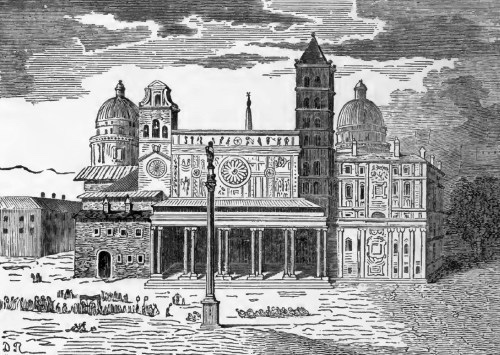
The Dedication of Saint Mary ad Nives”. Pictorial Lives of the Saints, 1922
There are in Rome three patriarchal churches, in which the Pope officiates on different festivals. These are the Basilics of Saint John Lateran, Saint Peter’s on the Vatican Hill, and Saint Mary Major. This last is so called because it is, both in antiquity and dignity, the first church in Rome among those that are dedicated to God in honor of the Virgin Mary. The name of the Liberian Basilic was given it because it was founded in the time of Pope Liberius, in the fourth century; it was consecrated, under the title of the Virgin Mary, by Sixtus III, about the year 435. It is also called Saint Mary ad Nives, or at the snows, from a popular tradition that the Mother of God chose this place for a church under her invoAugust cation by a miraculous snow that fell upon this spot in summer, and by a vision in which she appeared to a patrician named John, who munificently founded and endowed this church in the pontificate of Liberius. The same Basilic has sometimes been known by the name of Saint Mary ad Prcesepe, from the holy crib or manger of Bethlehem, in which Christ was laid at His birth. It resembles an ordinary manger, is kept in a case of massive silver, and in it lies an image of a little child, also of silver. On Christmas Day the holy manger is taken out of the case and exposed. It is kept in a sumptuous subterraneous chapel in this church.
Reflection – To render our supplications the more efficacious, we ought to unite them in spirit to those of all ferent penitents and devout souls, in invoking this advocate for sinners.
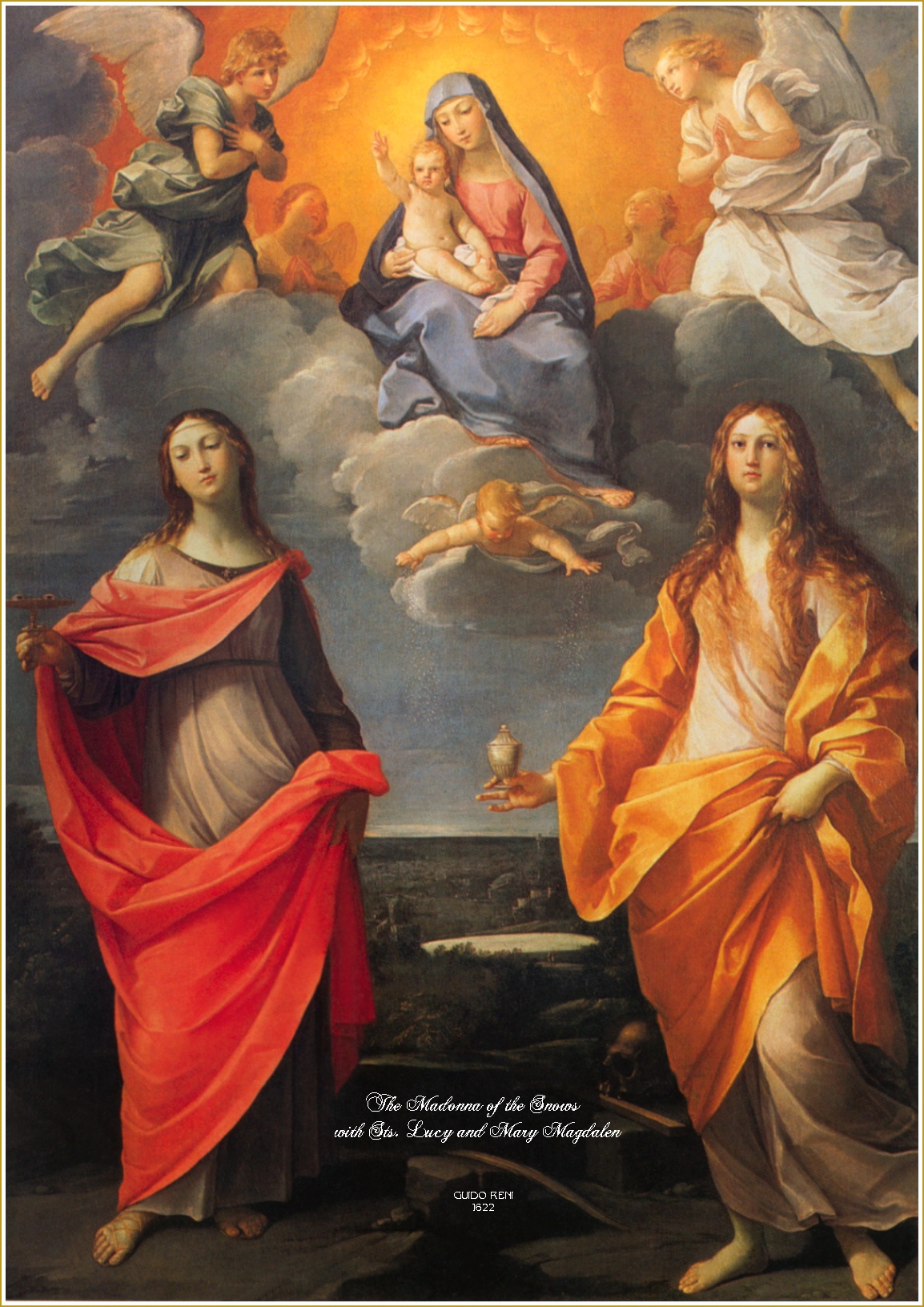
Watch Solemn Pontifical Mass on the Feast of Our Lady of The Snows
The present-day church is one of the largest basilicas in the world and its Patronal Festival is held on August 5 in remembrance of the miracle of the snow. During this celebration hundreds of white blossoms are showered from the dome of the chapel. Not to be missed are the thirteenth-century mosaics on biblical themes and the frescoes by Reni and Della Porta. There is an imposing Romanesque belltower erected in 1377.
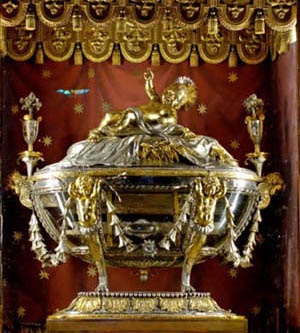
The sacra culla, the sacred crib that holds the wood of Our Lord’s Manger
Santa Maria Maggiore has a further claim to fame. In the seventh century a relic was brought from Bethlehem and traditionally venerated as the manger in which the Christ Child was laid at the first Christmas. And so another name for the great basilica is St. Mary of the Crib.
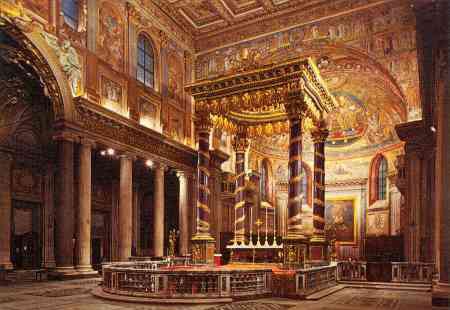
One of the most spectacular sights which meets today’s pilgrim is the triumphal arch which extends to almost 66 feet. It is decorated in four horizontal sections. In the middle at the top God’s throne is set in a circle, with St. Peter and St. Paul on either side. Above this mosaic are the symbols of the four Gospel writers.
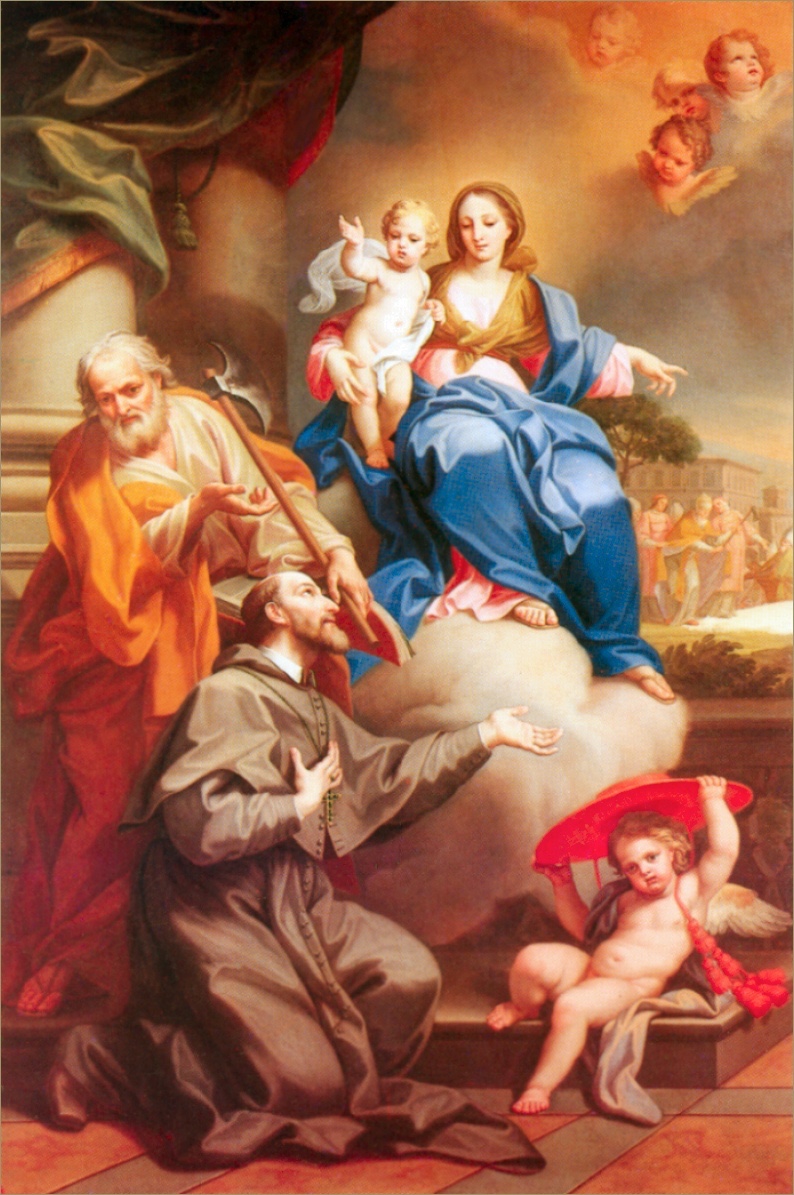
The Madonna of the Snows GAETANO LAPIS 1720
Prayer to Our Lady of the Snows
Our Lady of the Snows, Immaculate Queen of the Universe, from this privileged sanctuary, Thou has bestowed so many countless graces and pledges of love upon the hearts and souls of millions. O Mother, from this cradle of Christianity, this Mother Church of all churches, deign to shower forth the graces of thine Immaculate Heart upon the remnant Faithful throughout the world, wherever they may be, and grant them the graces of a childlike love and unwavering fidelity to the holy truths of our Faith. Grant, good Mother, to the faithful Bishops of the Church the grace to defend Her Sacred Teachings, and to persevere courageously against all the enemies of the Holy Church. Amen.
Leave a Reply